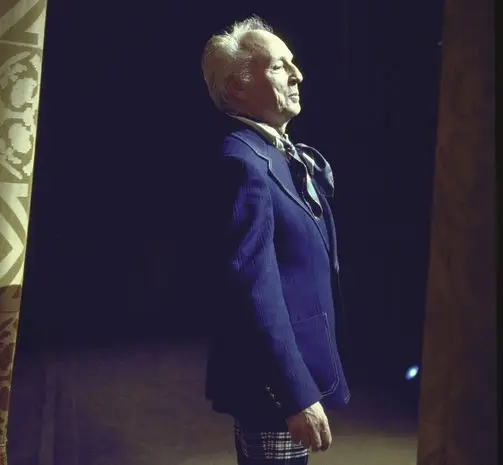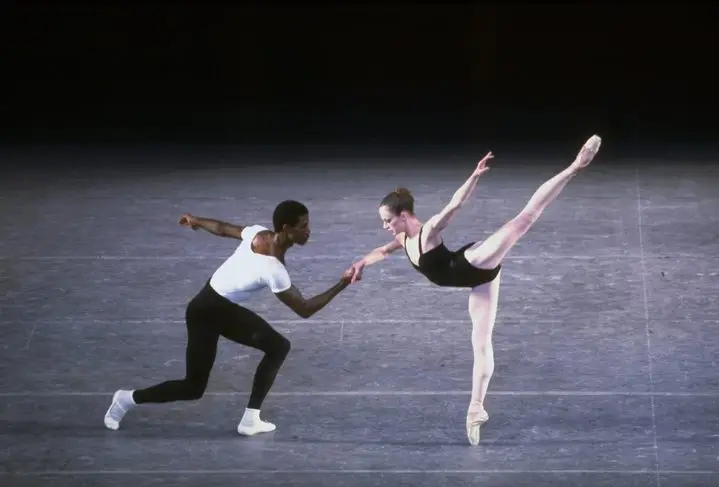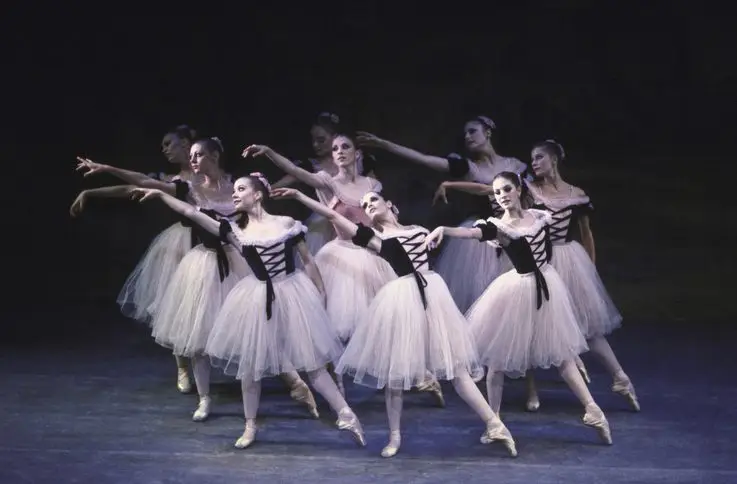Lauren King
lking@balanchine.org
Former NEW YORK CITY BALLET PRINCIPAL DANCERS MERRILL ASHLEY and ADAM LUDERS coach CHACONNE
New York City: On September 15, 2025, in the NYCB studios at Lincoln Center, Merrill Ashley and Adam Luders coached Boston Ballet principal dancers Lia Cirio and Patrick Yokum in the leading roles of Chaconne. Elaine Chelton, NYCB solo pianist, accompanied the coaching session and Elizabeth Kendall interviewed Ashley and Luders at its conclusion.
Set to “heavenly” strains of Gluck, the ballet Chaconne is an elaborate full-company work with a multipart pas de deux containing several variations for the male and female leading dancers within it, originally danced by Suzanne Farrell and Peter Martins.
The GBF Video Archives document the insights of dancers, often principals from original casts or those who worked closely with Balanchine. The Archives mission is to preserve this knowledge and pass it on to today's dancers, scholars, and audiences. The Archives are available world-wide through public and university libraries, and digitally through the George Balanchine Foundation website for those working in the dance field and using these resources in their work. In addition, the interview components can be accessed on the Balanchine Foundation's YouTube channel.
MERRILL ASHLEY, at thirteen was awarded one of the first Ford Foundation Scholarships to attend the School of American Ballet. Balanchine invited her to join the New York City Ballet in 1967 and later cast her in many technically challenging soloist and principal roles while still a corps member, most remarkably, Diamonds’ principal. In 1974 she was promoted to soloist, and in 1977, her promotion to principal dancer was announced in tandem with his plan to choreograph his first ballet for her, Ballo della Regina. In 1980, Balanchine challenged her prodigious gifts in a new, lyrical and “Proustian” way in his Ballade, which was tailor made for Ashley. NYCB’s technical standards of the time were raised, in large part because of her. Ashley retired on November 25, 1997, at a gala celebration. In summing up her career, the Wall Street Journal said, "she basically taught the world how ballet is danced." Currently, Ashley stages Balanchine ballets and has taught and staged widely. For the Interpreters Archive she previously taught and coached Ballo della Regina, Tschaikovsky Piano Concerto No. 2, Who Cares?, Diamonds with Jacques d’Amboise and Ballade with Adam Luders.
ADAM LUDERS began his ballet training at the Royal Danish Ballet School and graduated to become a member of the Royal Danish Ballet in 1968. He was a principal dancer with London Festival Ballet (1973–5) and New York City Ballet (1975–94) creating roles in Balanchine's Davidsbündertänze, Kammermusik No. 2, and Walpurgisnacht, as well as Robbins's In Memory of... among others. Since retiring he has taught widely, including at
the School of American Ballet, and staged Balanchine repertory for the George Balanchine Trust. Trained in the Bournonville tradition, Luders was the classic ‘danseur noble’. He is part of the last generation of dancers who worked closely with Balanchine at the New York City Ballet and has danced most of the Balanchine and Robbins repertoire. Luders is famous for his skill in pas de deux, and he has partnered most of Balanchine’s ballerinas as well other international stars. For the Interpreters Archive he has coached many ballets besides those choreographed on him, including the first movement of Brahms-Schoenberg Quartet, Ballade, La Valse, Orpheus and Vienna Waltzes.
LIA CIRIO trained at Swarthmore Ballet Theatre and Central Pennsylvania Youth Ballet. At age 16, she joined Boston Ballet II and joined Boston Ballet’s corps de ballet in 2004. Cirio was named second soloist in 2006 and soloist the following year. In 2008 and 2009, Cirio joined the Trey McIntyre Projects, and toured with the company in the United States and the world, returning to Boston Ballet in the 2009-10 season and was promoted to principal in 2010. She has danced roles such as Odette/Odile in Swan Lake and the title role in Cinderella, as well as Chaconne. Cirio has also choreographed work for Boston Ballet's ChoreograpHER initiative.
PATRICK YOCUM has been a Boston Ballet principal dancer since 2017. He began his ballet training in his home state of Pennsylvania. Yokum’s ballet studies continued in Boston Ballet’s Trainee Program before joining Boston Ballet II in 2009 and Boston Ballet in 2011. He has appeared in leading roles in the classical repertoire of Petipa, Ashton, Bournonville, and Cranko; as well as the more contemporary ballets of Robbins, Forsythe, Elo, and Peck. His Balanchine repertory includes Chaconne, Serenade, Agon, Tchaikovsky Piano Concerto No. 2, Allegro Brilliante, Stravinsky Violin Concerto, Donizetti Variations, and Apollo.
ELIZABETH KENDALL is a dance and culture critic and an associate professor of Writing/Literary Studies at New York's New School (Eugene Lang College and Liberal Studies graduate faculties). Her book Balanchine and the Lost Muse: Revolution and the Making of a Choreographer was published in July, 2013, by Oxford U. Press (paperback summer 2015). She has also written Where She Danced, (Knopf & U. of California Press); The Runaway Bride: Hollywood Romantic Comedy of the 1930's (Knopf & Cooper Square Press), two memoirs, American Daughter (Random House, 2000) and Autobiography of a Wardrobe (Pantheon and Anchor/Doubleday, 2006), and magazine, newspaper and journal articles. She has received fellowships from the Rockefeller, Guggenheim, and Fulbright Foundations, NYPL's Cullman Center for Scholars and Writers, the Likhachev Foundation of Russia, and the Leon Levy Center for Biography. She is at work on an experimental biography of Balanchine. For the GBF video Archives she has interviewed the coaches for Stravinsky Violin Concerto, Tarantella, excerpts from Vienna Waltzes andOrpheus, and the donkey pas de deux from A Midsummer Night's Dream.
NANCY REYNOLDS is the founding director of the George Balanchine Video Archives. She is a former dancer with New York City Ballet and has been Director of Research for The George Balanchine Foundation since 1994, when she conceived the Video Archives program. Among her books are Repertory in Review: Forty Years of the New York City Ballet; No Fixed Points: Dance in the Twentieth Century (with Malcolm McCormick); and Remembering Lincoln. In 2013 she received a “Bessie” award for “outstanding service to the field of dance.”
PAUL BOOS, Director of the Video Archives since 2021, is a former dancer with NYCB and répétiteur for the George Balanchine Trust. His work for the Trust has been presented at several theaters, including the Maryinsky, Bolshoi, Paris Opera, La Scala, Pacific Northwest Ballet, and Boston Ballet. He is the director of Rye Ballet Conservatory’s pre-pro division as well as a guest teacher abroad and locally.
The George Balanchine Foundation is a not-for-profit corporation established in 1983 with the goal of creating programs that educate the public and further Balanchine’s work and aesthetic. Among the GBF’s major initiatives are the Video Archives, in which dancers who worked closely with Balanchine teach and coach their roles with the dancers of today (Interpreters Archive) or recreate sections of ballets that are rarely performed or in danger of disappearing (Archive of Lost Choreography). Legendary dancers who have taken part in this project include Alicia Alonso, Jacques d’Amboise, Suzanne Farrell, Frederic Franklin, Melissa Hayden, Allegra Kent, Alicia Markova, Patricia McBride, Maria Tallchief, Violette Verdy, Patricia Wilde, Edward Villella, and others, working with dancers from such companies as New York City Ballet, American Ballet Theatre, Pittsburgh Ballet Theatre, and San Francisco, Boston, Pacific Northwest and Suzanne Farrell ballets.
In 2007 the Foundation announced a major initiative, the online publication of the Balanchine Catalogue, a fully searchable database giving first-performance details of all known dances created by Balanchine and supplemented by lists of companies staging his ballets, a bibliography, a videography, reference resources, a database of roles Balanchine performed, and related information. The project was made possible by a leadership grant from The Jerome Robbins Foundation. An expanded and updated version, enhanced by visuals, was introduced in June 2022 (www.balanchine.org).
The George Balanchine Foundation expresses its profound gratitude to the following donors: Agnes Gund, Barbara D. Horgan, The New York State Council on the Arts, the Pettit Foundation, Nancy R. Reynolds and The Rockefeller Brothers Fund; and to Robert Brenner, Leslie Tonner Curtis, Maureen Footer, Russell Vaille Lee, The National Endowment for the Arts, Meryl Rosofsky and Stuart H. Coleman, The Evelyn Sharp Foundation, Denise Littlefield Sobel, Resa and Heiner Sussner, and I. Peter Wolff.




